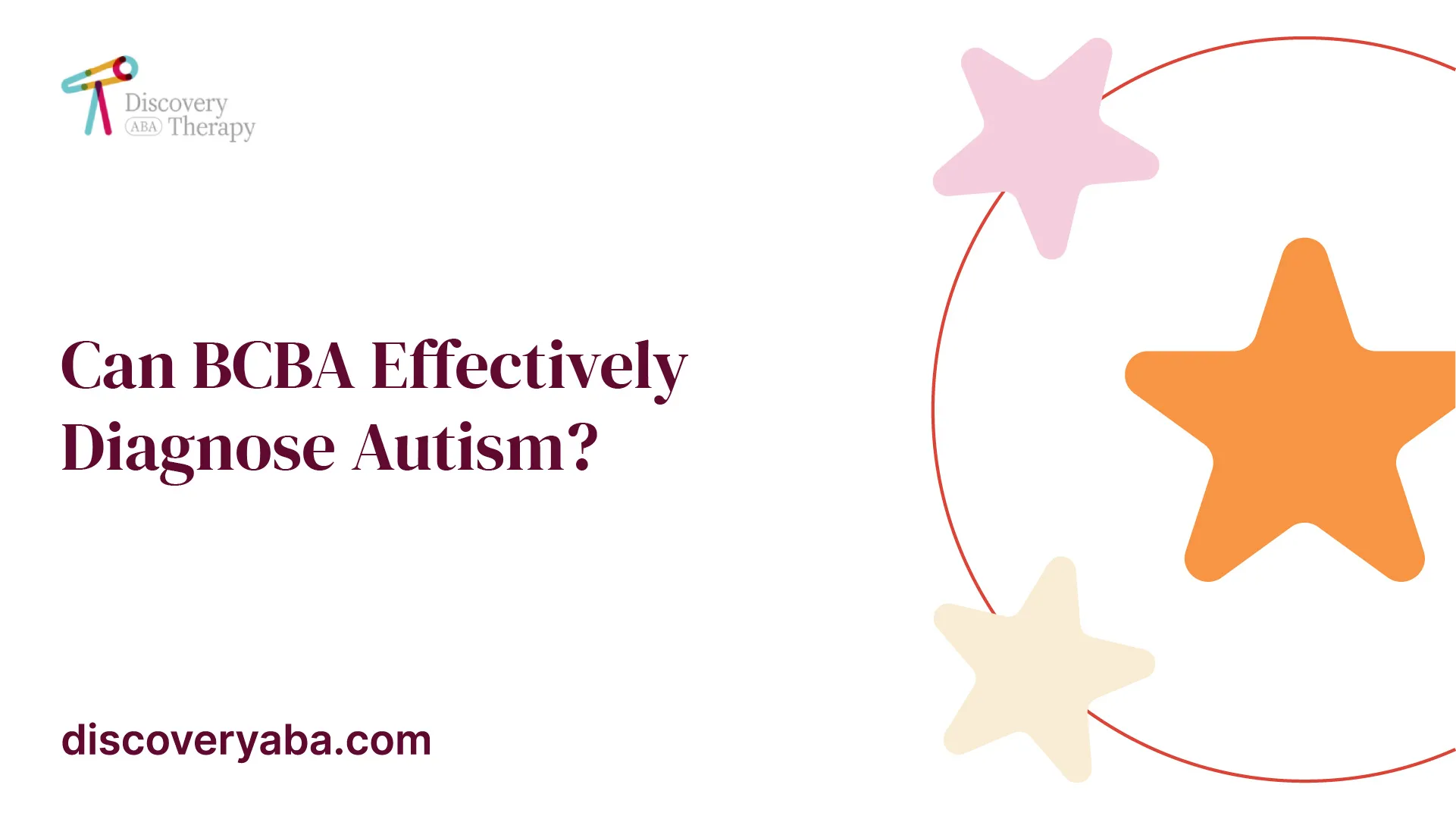Can BCBA Effectively Diagnose Autism?
Unraveling the role of BCBAs in autism diagnosis: their expertise, limitations, and impact on access to care. Can BCBA effectively diagnose autism?

Autism Screening and Diagnosis
When it comes to autism, early intervention is key. Identifying and diagnosing autism at an early stage allows for timely interventions that can significantly improve outcomes for individuals on the autism spectrum. In this section, we will explore the importance of early intervention and the screening guidelines and recommendations for autism.
Importance of Early Intervention
Research has consistently shown that intervening as early as possible is associated with more positive outcomes than delaying or not providing treatment at all. Early intervention focuses on addressing the specific needs of individuals with autism, promoting their development and improving their overall quality of life.
By starting intervention at a young age, children with autism can receive targeted therapies and support tailored to their unique challenges. Early intervention can help improve communication and social skills, reduce problem behaviors, and enhance cognitive and adaptive functioning. It also provides families with the knowledge and tools they need to support their child's development effectively.

Screening Guidelines and Recommendations
Screening for autism is a critical step in the diagnostic process. Early identification of autism through screening enables prompt referral for further evaluation and diagnosis. Screening guidelines and recommendations vary slightly among different organizations and healthcare providers, but they all aim to identify potential signs of autism and ensure timely intervention.
The American Academy of Pediatrics (AAP) suggests that autism screenings should be a part of standard 18 and 24-month well-child checkups. On the other hand, the National Center on Birth Defects and Developmental Disabilities (NCBDD) recommends screenings at 9, 18, and 24 or 30 months for all children [1].
It's important to note that screenings administered during well-child checkups are designed to indicate whether a child may be showing early signs of autism. These screenings help identify areas that require further assessment but do not replace a formal diagnosis. If a child screens positive for potential autism symptoms, further evaluation by specialists, such as developmental pediatricians, child psychologists, or pediatric neurologists, may be recommended to confirm the diagnosis.
Early screening and diagnosis play a crucial role in accessing appropriate interventions and services for children with autism. While recommendations exist for early screenings, the median age of autism diagnosis in the US is approximately 4.5 years old [2]. This discrepancy highlights the need for increased awareness and implementation of early screening practices to ensure that children receive the support they need as early as possible.
By following the recommended screening guidelines and promptly seeking further evaluation if necessary, parents and healthcare providers can work together to identify autism in its early stages and provide the necessary interventions to enhance the developmental outcomes for children on the autism spectrum.
Autism Diagnostic Process
When it comes to diagnosing autism, a comprehensive and multidisciplinary approach is necessary to ensure an accurate assessment. The diagnostic process typically involves a combination of screening and a comprehensive diagnostic evaluation conducted by a team of specialists, including neurologists, child psychologists, psychiatrists, and speech-language pathologists (SLPs).
Multidisciplinary Approach
With its complex nature, autism requires a multidisciplinary approach to accurately diagnose and assess individuals. This approach involves professionals from various fields who collaborate to gather comprehensive information about the individual's developmental history and current functioning. By considering multiple perspectives, the diagnostic team can gain a more holistic understanding of the individual's strengths and challenges.
Diagnostic Evaluation Components
The diagnostic evaluation for autism involves several components that contribute to a comprehensive assessment. These components may include:
- Developmental History: Gathering information about the individual's developmental milestones, social interactions, communication skills, and behavioral patterns. This information helps identify any developmental differences consistent with autism.
- Observations and Behavioral Assessments: Professionals use standardized diagnostic scales and tools to observe and assess the individual's behavior. One commonly used tool is the Autism Diagnostic Observation Schedule, Second Edition (ADOS-2), which involves trained evaluators assessing the individual's communication skills, social interaction, and imaginative use of materials through semi-structured observations [4].
- Medical and Genetic Evaluation: Ruling out other potential medical conditions or genetic disorders that may present with similar symptoms to autism. This evaluation helps ensure an accurate diagnosis and appropriate interventions.
- Parental Input: Gathering information from parents or caregivers about their observations and concerns regarding their child's development. Parental input is invaluable in providing insight into the child's behavior across different settings and contexts.
Diagnostic Tools and Observations
The diagnostic process for autism heavily relies on standardized diagnostic scales and tools for behavioral observation. These tools assist clinicians in quantifying observed behaviors, aiding in the diagnosis. While there is no medical or laboratory test for autism, these tools contribute to a more accurate assessment of autism based on behavioral patterns.
It's important to note that the diagnostic process may vary slightly depending on the healthcare provider or diagnostic center. However, the goal remains the same: to gather comprehensive information through a combination of assessments, observations, and evaluations to determine whether an individual meets the criteria for an autism diagnosis.
The diagnostic evaluation process typically takes between 1.5 to 3 hours on average, and parents may accompany their child throughout the assessment if separation difficulties arise [4]. The time and effort invested in the diagnostic process are essential for accurate diagnosis and to provide appropriate support and interventions for individuals with autism.
Professionals Involved in Diagnosis
The diagnosis of autism requires a comprehensive evaluation by qualified professionals who specialize in assessing developmental difficulties and behavioral disorders. Several professionals play a crucial role in diagnosing autism. These include developmental pediatricians, child psychologists, child psychiatrists, and pediatric neurologists.
Developmental Pediatricians
Developmental pediatricians are medical doctors who have specialized training in child development and behavior. They are qualified to diagnose autism and other developmental difficulties. Developmental pediatricians consider medical and psychosocial elements of children's behavior problems for diagnosis and treatment. They take into account the child's medical history, physical examination, and developmental milestones to make an accurate diagnosis. Their expertise lies in understanding the complex interaction between the physical and behavioral aspects of a child's development.
Child Psychologists
Child psychologists specialize in studying and understanding children's social, emotional, and mental development. They diagnose and treat various developmental, social, and emotional issues, including autism. Child psychologists undergo rigorous education and training to acquire the necessary expertise. They use a range of psychological assessments, interviews, and observations to evaluate a child's behavior and development. These professionals play a vital role in assessing and diagnosing autism, as they possess in-depth knowledge of child development and behavior.
Child Psychiatrists
Child psychiatrists are licensed physicians who specialize in diagnosing and treating behavioral disorders in children. Unlike child psychologists, child psychiatrists can prescribe medication as part of their treatment approach. They must meet rigorous education and training criteria before earning a license. Child psychiatrists employ their medical knowledge and expertise to evaluate children with developmental difficulties, including autism. They assess the child's behavior, emotions, and overall mental health to form a diagnosis and develop an appropriate treatment plan.
Pediatric Neurologists
Pediatric neurologists are medical doctors who specialize in treating children with conditions affecting the nervous system. They play a crucial role in diagnosing and treating developmental delays, headaches, seizures, and other related conditions. Pediatric neurologists have specific education and training requirements that enable them to evaluate children with developmental difficulties, including autism. They utilize their expertise in neurology to assess a child's neurological development and identify any abnormalities or signs of autism.
These professionals work collaboratively to provide a comprehensive evaluation and diagnosis for children suspected of having autism. Their specialized knowledge and experience in child development and behavioral disorders enable them to accurately identify autism and develop appropriate treatment plans tailored to each child's needs. It is important to consult with these professionals to ensure a thorough and accurate diagnosis of autism.
Role of BCBAs in Autism
While Board Certified Behavior Analysts (BCBAs) play a crucial role in managing and treating symptoms associated with Autism Spectrum Disorder (ASD), it's important to note that their scope of practice does not typically include diagnosing autism. The responsibility of diagnosing autism usually falls on medical professionals such as developmental pediatricians, child psychologists, child psychiatrists, or pediatric neurologists who have specialized training in autism diagnosis [5].
Behavior-Analytic Services
BCBAs are highly trained professionals who specialize in behavior analysis and behavior change strategies. They utilize evidence-based interventions, such as Applied Behavior Analysis (ABA), to address the behavioral challenges associated with autism. These services focus on developing and implementing individualized treatment plans to improve social, communication, and adaptive skills in individuals with autism.
Scope of Practice
While BCBAs are qualified to conduct behavioral assessments for Autism Spectrum Disorder (ASD) and Attention Deficit Hyperactivity Disorder (ADHD), their role primarily focuses on assessing behaviors and developing appropriate treatment plans based on those assessments. BCBAs utilize their expertise in behavior analysis to understand the function and patterns of behavior, providing strategies and interventions to improve the quality of life for individuals with autism.
Limitations in Diagnosing Autism
BCBAs generally do not diagnose autism because it may create a conflict of interest. The primary aim of a BCBA is to provide effective treatment and therapy to individuals with autism. Diagnosing a client for whom they would then provide services may compromise the objectivity and impartiality needed in the diagnostic process [5].
Diagnosing autism typically involves a comprehensive assessment conducted by a team of professionals, including specialists such as psychologists, psychiatrists, pediatricians, and clinical diagnosticians, who have received specialized training in diagnosing ASD. These professionals employ standardized diagnostic tools, observation, and clinical judgment to make an accurate diagnosis.
In conclusion, while BCBAs are essential members of the care team for individuals with autism, their role primarily focuses on providing behavior-analytic services and developing treatment plans. The diagnosis of autism typically falls within the purview of medical professionals with specialized training in autism diagnosis. It is important for parents seeking a diagnosis for their child to consult with a team of professionals experienced in diagnosing autism to ensure a comprehensive and accurate assessment.
Board Certified Behavior Analysts (BCBAs)
Board Certified Behavior Analysts (BCBAs) play a significant role in the field of autism and behavior analysis. They are highly trained professionals who provide behavior-analytic services and may supervise other professionals involved in implementing behavior-analytic interventions. Let's take a closer look at their qualifications, training, and the application process to become a BCBA.
Qualifications and Training
To become a BCBA, individuals must meet specific qualifications and complete a comprehensive training program. The qualifications include:
- Holding at least a master's degree in behavior analysis or a related field.
- Completing specific coursework in behavior analysis, including principles of behavior, behavior assessment, behavior change procedures, and ethical considerations.
In addition to the educational requirements, individuals must also gain practical experience in behavior analysis through supervised fieldwork. The fieldwork experience must consist of a certain number of hours, including direct client contact and supervision by a qualified BCBA.
Once the educational and fieldwork requirements are met, individuals are eligible to sit for the BCBA certification exam. This exam assesses knowledge and understanding of behavior analysis principles and practices.
BCBA vs. BCBA-D
BCBAs who have obtained doctoral or postdoctoral training in behavior analysis may apply for the designation of Board Certified Behavior Analyst-Doctoral (BCBA-D). The BCBA-D designation does not grant any additional privileges beyond BCBA certification, but it recognizes individuals who have achieved additional training in behavior analysis.
Application Process and Requirements
To apply for BCBA certification, individuals must complete an application, provide all required supplemental documentation, and pay the application fee. The application process includes different options based on whether the applicant has completed an ABAI-accredited doctoral program or a doctoral program from a qualifying accredited institution.
Applicants for the BCBA-D designation must follow the same application process as BCBA certification. The application includes a fee of $105, which must be paid before the review process begins. It's important to note that incomplete applications expire 90 days after the payment date, so it's essential to ensure all required documentation is submitted in a timely manner.
Once individuals become certified as BCBAs or BCBA-Ds, they must adhere to the same information and requirements outlined in the BCBA Handbook. This includes maintaining supervision qualifications and fulfilling continuing education and recertification requirements.
Board Certified Behavior Analysts (BCBAs) play a vital role in the diagnosis and treatment of autism spectrum disorder. Their expertise in behavior analysis and their commitment to ongoing professional development contribute to the effective implementation of behavior-analytic interventions.
Access to Autism Diagnosis
Ensuring access to timely and accurate autism diagnosis is crucial for individuals with Autism Spectrum Disorder (ASD) and their families. Unfortunately, there are disparities in access to diagnosis, which can hinder early intervention and support. This section will explore the disparities in access to autism diagnosis, geographic disparities, and efforts to improve access.
Disparities in Access
Disparities in access to autism diagnosis exist, particularly in certain regions and communities. Provider shortages and limited resources contribute to these disparities, resulting in delayed or inadequate diagnosis for some individuals with ASD. According to a study, while the number of Registered Behavior Technicians (RBTs) has significantly increased over the years, there are still significant unmet needs in various states in the United States, indicating disparities in access to Applied Behavior Analysis (ABA) services for children with ASD.
Geographic Disparities
Geographic disparities play a significant role in access to autism diagnosis. Access to Board Certified Behavior Analysts (BCBAs), who are an essential part of the diagnostic process, can vary depending on the location. Efforts to improve access should focus on non-urban and less affluent counties, as these areas often face challenges in provider recruitment and maintenance. By targeting these regions, access to BCBAs can be enhanced, ensuring that individuals with ASD receive the necessary diagnostic evaluations and interventions.
To better understand the geographic disparities in access, let's take a look at the following table:

Efforts to Improve Access
Efforts are underway to address the disparities in access to autism diagnosis. Various organizations, policymakers, and advocacy groups are working to improve access and ensure that individuals with ASD receive the necessary evaluations and support. Some initiatives include:
- Increasing Provider Recruitment: Efforts are being made to recruit and train more professionals, such as BCBAs, in underserved areas. By increasing the number of providers, access to autism diagnosis can be improved, especially in regions facing shortages.
- Telehealth Services: Telehealth services have gained prominence, particularly in response to the COVID-19 pandemic. This approach allows individuals to receive remote diagnostic evaluations, reducing barriers related to geographical distance and improving access to diagnosis.
- Community Partnerships: Collaborations between healthcare organizations, schools, and community centers can help expand access to autism diagnosis. By establishing partnerships, resources can be shared, and interdisciplinary teams can work together to provide comprehensive evaluations and support services.
Through these efforts and continued advocacy, strides can be made to bridge the gaps in access to autism diagnosis and ensure that individuals with ASD have the opportunity for early intervention and appropriate support. It is essential to prioritize equitable access to diagnosis to improve outcomes for individuals with autism and promote their overall well-being.
References
- https://www.bacb.com/bcba/
- https://www.ncbi.nlm.nih.gov/pmc/articles/PMC7900801/
- https://www.nhs.uk/conditions/autism/getting-diagnosed/assessments/
- https://www.ncbi.nlm.nih.gov/pmc/articles/PMC9777418/
- https://adsd.nv.gov/uploadedFiles/adsdnvgov/content/Programs/Autism/ATAP/Autism%20Diagnostic%20Process.pdf
- https://www.ncbi.nlm.nih.gov/pmc/articles/PMC3269006/
- https://www.nhs.uk/conditions/autism/getting-diagnosed/how-to-get-diagnosed/
- https://www.ncbi.nlm.nih.gov/pmc/articles/PMC8891635/
Does Your Child Have An Autism Diagnosis?
Learn More About How ABA Therapy Can Help
Find More Articles
Contact us
North Carolina, Tennessee, Nevada, New Jersey, Utah, Virginia
New Hampshire, Maine
Massachusetts, Indiana, Arizona, Georgia
.avif)










































































%2520(1).jpeg)


















